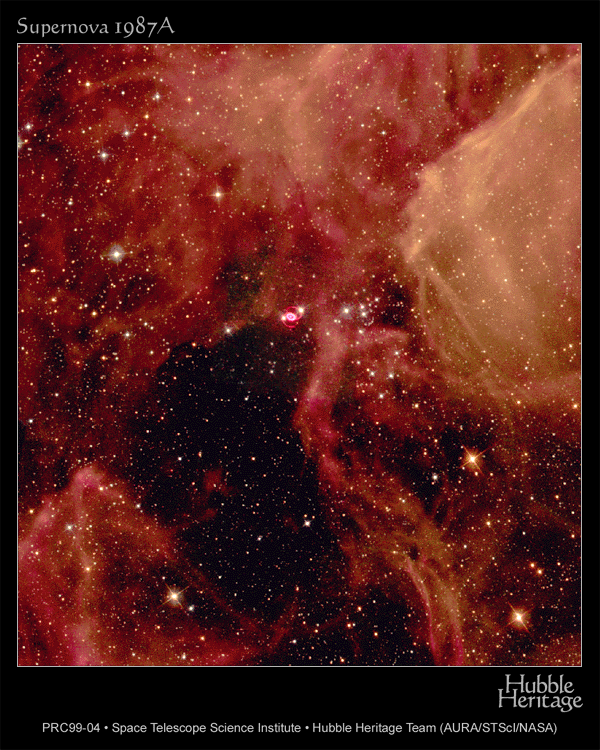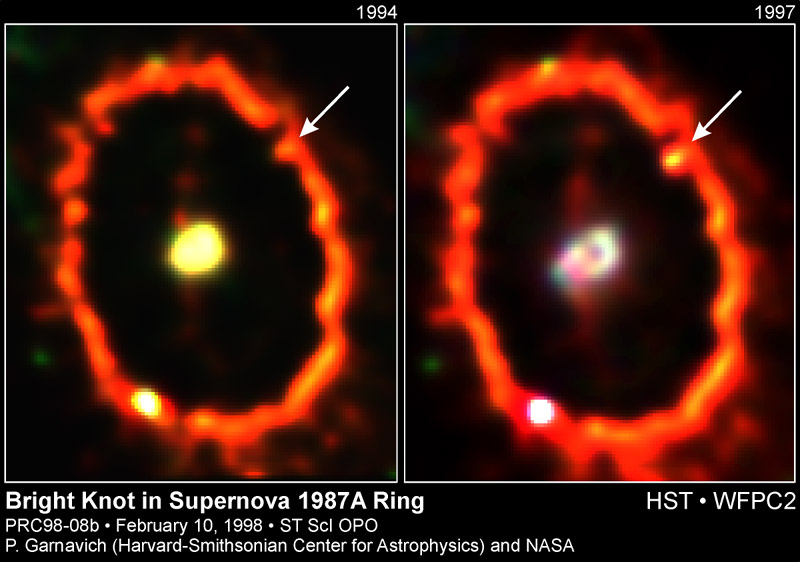Stars form as a cloud of gas collapses. Gravity packs the gas closer
and closer together. This raises the temperature and eventually the
gas is hot enough for nuclear reactions to start. The proton-proton
chain converts H to He. The star is now on the main sequence of the
H-R diagram. The H burning takes place in the core initially. The
fraction of H in the core was initially 75% but in the sun, this is
now decreased to 30% or so as He has been created.

The Sun was originally a little bit smaller than it is today. This is
because He contains less particles than H so gravity can compress the
core. This raises T which generates a higher pressure out from the
core. This causes the outer layers to expand slightly (core and outer
layers behave quite separately in stellar evolution). H burning starts
to occur in the shells out of the core which are closer to the surface
which also creates and outward pressure, causing the sun to expand.

More massive stars actually burn their H faster than smaller stars -
live fast, die young (leave a good looking corpse) is the way I
remember it. t propto 1/M^2.5 .

Once the H in the core runs out the stars enter their next phase - the
Red Giant phase. Nuclear reactions stop. Pressure decreases a bit and
gravity can contract the core further, increasing the temperature. The
increased temperature causes the reactions in the shell to burn faster
and faster and exert an outward pressure. The converted He falls onto
the core, increasing the gravity and T. The core of a 1Msun star
compresses to 1/3 of it's size at this stage. The outer layers feel
the outward pressure and expand drastically as the core contracts. The
expansion cools the outer layers and T drops, hence star appears
redder. The luminosity of these objects is high though cos of large
radius.

This is what a star looks like in the first three stages. In very low
mass stars M < 0.7 Msun, gravity is never strong enough to raise T
higher than 10^8K required for He to start burning. We'll come back to
this case.

Stars with mass in the range 1-2 Msun can raise T high
enough to start He burning however the He starts burning in a He
flash. These low mass stars are so compact when the Temperature gets
to 10^8 K the gravity is balanced by something called electron
degeneracy pressure - the electrons are resisting being pushed
together. When He starts to burn the T is free to rise dramatically
and a lot of He is burnt very quickly. Eventually T gets high enough
that it is more important than the electron degeneracy pressure, the
core expands slightly and He burns as normal. The He flash is not
actually seen as a flash of light - most of the energy is used to heat
the core and stop the degenerate state. The outer layers absorb any of
the heat that is released. As the core expands, T drops and the outer
layers contract as less pressure outwards so the radius decreases. As
the radius decreases, the surface temperature increases. Moves on H-R
diagram.
For a star with mass > 2 Msun, the gravity is high enough to raise T
and start He burning with out the core becoming degenerate. No helium
flash.
He burns into C and O via a process called the triple alpha reaction.

Globular clusters are useful for testing stellar models. All stars
formed at same time, range of sizes though. All at same d so get
relative L's.

When we look at globular clusters, we find part of the main sequence
is missing.

This is because the stars have evolved off the main sequence. The turn
off position reveals their ages - the more of the main sequence that
survives, the younger the globular cluster.

As an aside, there are also some special stars that come up later that
have special places on the HR diagram. These are RR Lyrae's, Cepheids
and Mira variables. Their brightness changes on well known timescales.

They are found on the instability strip. They have a P-L relation - if
you period can imply their peak luminosity and hence get distance -
standard candles.

Cepheid light curves.

Back to stellar evolution:
As said, as the He starts burning, core expands and cools
slightly. The shell therefore releases energy more gradually so L goes
down. Surface T increases though as outer layers contract a bit. Moves
across the horizontal branch. Eventually the He in the core is used up though
(roughly lasts in this phase for 20% of the main sequence
time). Shells are still burning H and He. The products of this (C and
O) fall onto the core and it contacts. T increases but this time for
all low mass stars (M < 4Msun or so), electron degeneracy pressure is
important and gravity can never raise T high enough to start C
burning. This is where the star effectively dies. The core contracts
and T is increased, This causes the shell burning to happen faster
which causes the outer layers to expand. Surface T goes down but R
increases rapidly so L increases up the asymptotic giant branch.

The sun will become so swollen at this stage that mars will be eaten
by it. The core though is so compact that it is not much larger than
the earth!

Again globular clusters help provide our model evidence as we see the
asymptotic giant branch.

The next stage for low mass stars (and we'll include the ones where He
burning never started again) is the planetary nebular phase. This has
nothing to do with planets. H and He (or just H) are burning in the shell. They
create thermal pulses outwards. This causes the outer layers of
non-burning H and
He to expand outwards. This goes on for a while but eventually the
outer layers are so expanded that they no longer feel the
gravitational pull of the core and they are ejected off from the
star. 40% of the stars original mass can be lost here. We see
20,000-50,000 PN in our galaxy. We can use the doppler shift to work
out how fast they are expanding.

Their projection can give rise to cool looking objects. Eventually
they become so diffuse you cannot see them. 5Msun of H and He (and
bits of C and O also escape) are put back into the interstellar
medium each year via this process.

What are then left with is the core. This is an object known as a
white dwarf. The first one to be detected was Sirius neighbour - the
little splodge.

The WD is not burning anymore. Gravity is supported by electron
degeneracy pressure. They are very dense - 10^19 kg/m^3, the size of
the earth and they cool down passively with time. They have an unusual
mass-radius relation - the more mass, the smaller the radius. There is
an upper limit known as the Chandrasekhar limit.

Different mass WD's cool differently with time.

High mass stars (M>4Msun or so)
are very different. Gravity is high enough to raise T
to start C burning before the core becomes degenerate. T is high
enough to burn C, O, Ne, Si etc. The star goes back and forth on the
HR diagram, becomes very large and a lot of the outer layers are
ejected off from the star.

This is the 'onion' skin diagram. All elements up to iron can be
burnt. Iron is a special cases though. Burning iron is an endothermic
reaction rather than an exothermic one i.e. it requires energy to fuse
iron into something else rather than releasing energy. This is because
the positively charged protons in the core of the iron atom resist
further protons being added to them. This is the death of high mass
stars. Core at high T. The final reaction generates neutrinos that
escape and take energy with them. The core contracts, increasing
T. The photons in the core are very energetic. They smash into the
iron atoms and break them up - photodisintegration. Gravity then
contracts core further, forcing protons and electrons to combine: P +
e = n + neutrinos. Again the neutrinos escape. After 0.25s the core <
20 km in diameter and density 4x10^14 kg/m^3. Neutron degeneracy
pressure kicks in - however it is too slow. Imagine driving and
suddenly seeing a wall. If you are too late applying the breaks - you
slam into it and bounce back. That is what happens here. The
contracting core feels the wall of neutron degeneracy pressure and
bounces back. This sends a shock wave through the star which blasts
the outer layers off in an event called a Type II supernova. 96% of
the mass is released back into the ISM and all the heavy elements in
the universe are formed here - we are made of star dust. The cores
create something called a Neutron star or a Black Hole (depending on
initial mass and mass remaining).

The stages.

A supernova 1987a.

Lightcurve of 1987a





Other types of supernova occur. If a WD is in a binary system then
mass from the neighbour star as it enters the red giant phase can be
transfered onto it via a process called accretion. This pushed the
mass of the WD over the Chandrasekhar limit and the star explodes. This
is a type Ia supernova.

Type Ia and

Type II are the important types here.

Type Ia are believed to be standard candles - their peak luminosity is
understood.

Lots of weird reactions occur in the blasted off layers. See lovely
supernova remnants.

Heavy elements (not H, He, Li, Be, C, O but all the others) created here

Summary of stellar evolution



